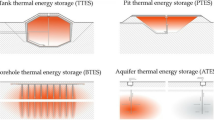Abstract
District heating networks present a high potential for the transition of the heat energy sector, both technically and organisationally. They allow integration of renewable energy, improve the overall energy efficiency, as well as facilitate sector coupling (coupling between heating, electricity and mobility). Many district heating systems could be upgraded by improvements at the side of the heat consumption, heat distribution and heat generation. The EU project Upgrade DH (H2020; Contract No. 785014; www.upgrade-DH.eu) supports the upgrading and retrofitting process of DH systems in different climate regions of Europe, covering various countries. Core activities of the Upgrade DH project include the collection of the best upgrading measures and tools, the support of the upgrading process for selected district heating networks, the organisation of capacity building measures about DH upgrading, financing and business models, as well as the development of national and regional action plans. Overall Upgrade DH approach should lead to more efficient district heating networks and sustainable solution for the heating sector. The specific upgrading opportunities need to be identified, described, assessed and translated into Key Performance Indicators (KPI) which may allow the results to be monitored as the action gets implemented. In this paper, the upgrading method is demonstrated on Tuzla DH, one of demo-cases considered under Upgrade DH project. In developing the upgrading measures for Tuzla DH, three measurable objectives 20/20/20 were taken into account, namely (i) 20% increasing energy efficiency (reducing annual primary energy demand from 350 GWh down to 270 GWh), (ii) 20% increasing RES (from 0 up to 20% of RES) and (iii) 20% reducing CO2 emission (CO2 cut from today 115,000 t/a emitted in producing 350 GWh of heat down to max. 92,000 tCO2/a. By identified and prepared upgrading measures, those targets are highly exceeded.
Access this chapter
Tax calculation will be finalised at checkout
Purchases are for personal use only
Similar content being viewed by others
References
Werner, S.: International review of district heating and cooling. Energy 137, 617–631 (2017)
European Commission: An EU strategy on heating and cooling, communication. COM 2016, p. 51. Brussels (2016)
Sayegh, M.A., et al.: Trends of European research and development in district heating technologies. Renew. Sustain. Energy Rev. 68, Part 2, 1183–1192 (2017)
Connolly, D., et al.: Heat roadmap Europe: combining district heating with heat savings to decarbonise the EU energy system. Energy Policy, 65, 475–489 (2014)
Lund, H., et al.: Smart Energy systems and 4th generation district heating. Energy 110, 1–4 (2016)
Rutz, D., et al.: Small heating grids for communities in Balkan countries: The CoolHeating Project. In: 5th International Solar District Heating Conference, Graz, Austria; 11 and 12 Apr 2018
Kazagic, A., Merzic, A., Redzic, E., Tresnjo, D.: Optimization of modular district heating solution based on CHP and RES—demonstration case of the municipality of Visoko. Energy 181, 56–65. https://doi.org/10.1016/j.energy.2019.05.132
Mergner, R., et al.: Upgrading the performance of district heating networks in Europe. In: 27th European Biomass Conference & Exhibition, 27–30 May 2019, Lisbon, Portugal (2019)
Rutz, D., et al.: Transition towards a sustainable heating and cooling sector—case study of southeast European countries. Thermal Sci. 23(6), 3293–3306
Kazagic, A., Merzic, A., Tresnjo, D., Music, M.: Horizon 2020 projects of EPBiH—Transition of power system by upgrade of power production technologies (in Bosnian: Horizont 2020 projekti EPBiH—Tranzicija EES unapređenjem tehnologija u proizvodnji energije), 14. In: CIGRE Conference, Neum, Bosnia and Herzegovina, 20–23.10.2019
Kazagic, A., Merzic, A., Tresnjo, D., Music, M.: Energy transition of power utility JP Elektroprivreda BiH through upgrading and retrofit of the generation portfolio supported by Horizon 2020 projects. In: 11th Days of BHAAAS—International Symposium on Innovative and Interdisciplinary Applications of Advanced Technologies—IAT 2019, Sarajevo 20–23 June 2019. Paper published also in Springer: https://springerlink.bibliotecabuap.elogim.com/chapter/10.1007/978-3-030-24986-1_43
Karabegovic, A.: Energy efficiency improvement and optimal management of CHP district heating system—case city of Tuzla, chemical engineering transactions (AIDIC—The Italian Association of Chemical Engineering), vol. 42, pp. 7–12 (2014)
Upgrading the performance of district heating networks in Europe, Horizon 2020 Project No: 785014, Methodological guidelines and fact sheet for the demo case of Tuzla DH, WP4—Task 2/D 4.2, February 2020
Hura, A., Saric, S., Halilcevic, M.: Additional solar heating sources in transition of district heating systems into smart/intelligent thermal grid. EU Solar District Heating Conference, Graz 11–12th Apr 2018
Acknowledgements
The authors would like to thank the colleagues of the Upgrade DH partners for their contributions in the project. The authors would like to thank the European Commission and the EASME for the support of the Upgrade DH project. Upgrade DH has received funding from the European Union`s Horizon 2020 research and innovation programme under grant agreement No 785014.
Disclaimer: The sole responsibility for the content of this paper lies with the authors. It does not necessarily reflect the opinion of the European Union. Neither the EASME nor the European Commission are responsible for any use that may be made of the information contained therein.
Author information
Authors and Affiliations
Corresponding author
Editor information
Editors and Affiliations
Rights and permissions
Copyright information
© 2021 The Editor(s) (if applicable) and The Author(s), under exclusive license to Springer Nature Switzerland AG
About this chapter
Cite this chapter
Kazagic, A. et al. (2021). Sustainable Transition of District Heating Networks—Upgrading the Performance of DH System Tuzla and Integration of RES Modules. In: Avdaković, S., Volić, I., Mujčić, A., Uzunović, T., Mujezinović, A. (eds) Advanced Technologies, Systems, and Applications V. IAT 2020. Lecture Notes in Networks and Systems, vol 142. Springer, Cham. https://doi.org/10.1007/978-3-030-54765-3_32
Download citation
DOI: https://doi.org/10.1007/978-3-030-54765-3_32
Published:
Publisher Name: Springer, Cham
Print ISBN: 978-3-030-54764-6
Online ISBN: 978-3-030-54765-3
eBook Packages: Intelligent Technologies and RoboticsIntelligent Technologies and Robotics (R0)




